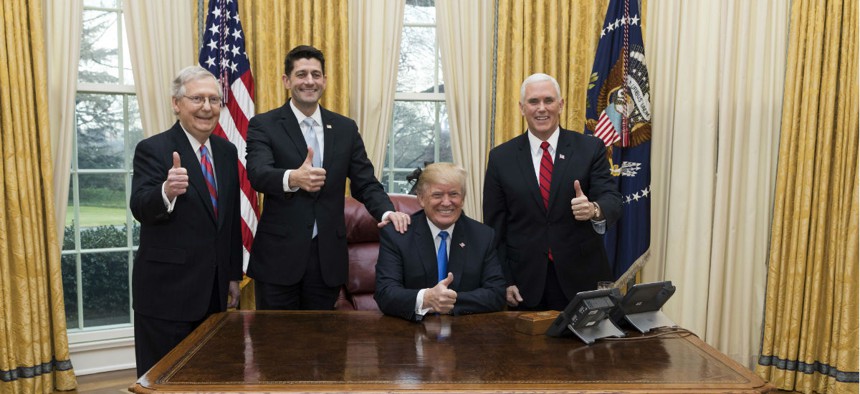
President Trump celebrates the passage of the Tax Cuts Act with Vice President Mike Pence, Senate Majority Leader Mitch McConnell, and Speaker of the House Paul Ryan on Dec. 20. Official White House Photo by Joyce N. Boghosian
Trump’s ‘Big, Beautiful Tax Cut’ Holds Some Big Unknowns for Government
The political fallout could be significant.
At President Trump’s big pre-Christmas tax cut celebration, he proudly told everyone, "I promised the American people a big, beautiful tax cut for Christmas.” And, he added, “that is exactly what they are getting.”
The spin machines are going full blast to tell us whether we’re better or worse off, but we’ll be buried in rhetoric long before we actually know how the bill will work out. Here’s why.
All the old tax tables are obsolete. As well as the W-4 forms, used to figure out withholding. Filling out that monsterpiece is a memory most of us have long since repressed.
The Treasury Department is scrambling to produce new tax tables. Then taxpayers will have to work through new W-4 forms—or leave it to the guesstimates of their payroll departments—to determine what their take-home pay will be.
For a lot of taxpayers, living in low-tax states with low mortgages, it will be a relatively easy job. They’ll fall into lower rates with the standard deduction. But for many taxpayers in higher-tax states like Virginia, Maryland, and the District of Columbia, it gets much more complicated, with the new $10,000 cap on state and local tax deductions and limits on deductions for new home mortgages. That’s going to affect withholding and, depending on how good the accountants are and how complicated a taxpayer’s situation might be, determining whether take-home pay is higher or lower is going to be very tricky.
And that’s even before we get to the spring of 2019. Some taxpayers may get an ugly surprise if they fail to have enough taxes withheld and end up writing a check to Uncle Sam, or if they fail to get the big tax refund they are used to.
Then there’s the puzzle of what will happen to state and local government revenues. Take Maryland as an example: Republican Governor Larry Hogan said that he expects hundreds of millions of unexpected dollars to roll into the state treasury. The state has to guess on just what impact the federal tax bill will have on state revenues and do it fast, since the governor needs to submit his budget in just a few weeks.
He’s promised “to protect our taxpayers”—not an easy promise to keep in a state where the average deduction for state and local taxes is almost $13,000, well above the new $10,000 cap. Does the state push the windfall (which will come from lower deductions and a higher taxable income) back to those who lose federal deductions, and risk the charge of spending money on the rich? Or does the state send it to the poor, and leave those who lost deductions very unhappy? And then there’s the very big worry that the cap on state and local tax deductions will increase the pain of the taxes, and that could make it that much harder to fund state and local services. This same drama will play out across the country.
In addition, Moody’s Analytics predicts that the average home price will be 4 percent lower by mid-2019, compared with what would have happened without tax reform. (That’s because of the combined impact of the new caps on mortgage interest deductions and the cap on state and local taxes.) Property taxes might come down, but if property values fall, it could feel like very bad news for the many families whose home is their single biggest piece of savings.
How is this all going to work out? The only sensible answer is: no one really knows.
But not knowing the answer certainly isn’t going to slow down the political spin. That’s because tax reform is shaping up as one of the pivotal battles of the 2018 midterm elections. Trump has already staked out the bill as “big and beautiful.” The Democrats are salivating at the chance to characterize the bill as a Republican plot to help the rich and the big corporations.
Two things are certain. One is that it’s going to take some time for everyone to figure out what the real impact of the tax bill really will be on their wallets. The other is that neither party is going to wait for reality to sink in before telling us what they want us to believe.
Until, that is, until reality shakes itself out, taxpayers look inside their wallets, and figure out whether they really do feel better off. The 2018 races will happen before that answer is clear. After that, it’s anyone’s guess, but it isn’t foolish to imagine this could become a truly pivotal issue for the 2020 presidential campaign. That’s when taxpayers will decide just how big and beautiful the tax bill turned out to be—and saying so won’t make it so if it isn’t so.
NEXT STORY: D.C.-Area Agencies Open Two Hours Late







